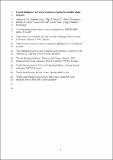Files in this item
Crowd intelligence can discern between repertoires of killer whale ecotypes
Item metadata
| dc.contributor.author | Danishevskaya, Anastasya Yu. | |
| dc.contributor.author | Filatova, Olga A. | |
| dc.contributor.author | Samarra, Filipa I P. | |
| dc.contributor.author | Miller, Patrick J O. | |
| dc.contributor.author | Ford, John K B | |
| dc.contributor.author | Yurk, Harald | |
| dc.contributor.author | Matkin, Craig O. | |
| dc.contributor.author | Hoyt, Erich | |
| dc.date.accessioned | 2019-10-31T00:36:55Z | |
| dc.date.available | 2019-10-31T00:36:55Z | |
| dc.date.issued | 2018-10-31 | |
| dc.identifier | 256460382 | |
| dc.identifier | 181522d2-d6f6-43d3-bf87-e76c23a7e6db | |
| dc.identifier | 85055862864 | |
| dc.identifier | 000507252300002 | |
| dc.identifier.citation | Danishevskaya , A Y , Filatova , O A , Samarra , F I P , Miller , P J O , Ford , J K B , Yurk , H , Matkin , C O & Hoyt , E 2018 , ' Crowd intelligence can discern between repertoires of killer whale ecotypes ' , Bioacoustics , vol. Latest Articles . https://doi.org/10.1080/09524622.2018.1538902 | en |
| dc.identifier.issn | 0952-4622 | |
| dc.identifier.other | RIS: urn:2AE82DDA7959EFAD287D6A771385E1FC | |
| dc.identifier.uri | https://hdl.handle.net/10023/18808 | |
| dc.description | This study was funded by the Russian Fund for the Fundamental Research (grant No. 18-04-00462). | en |
| dc.description.abstract | Call classifications by human observers are often subjective yet they are critical to studies of animal communication, because only the categories that are relevant for the animals themselves actually make sense in terms of correlation to the context. In this paper we test whether independent observers can correctly detect differences and similarities in killer whale repertoires. We used repertoires with different a priori levels of similarity: from different ecotypes, from different oceans, from different populations within the same ocean, and from different local subpopulations of the same population. Calls from nine killer whale populations/subpopulations were pooled into a joint sample set, and eight independent observers were asked to classify the calls into separate categories. None of the observers’ classifications strongly followed the known phylogeny of the analyzed repertoires. However, some phylogenetic relationships were reflected in the classifications substantially better than others. Most observers correctly separated the calls from two North Pacific ecotypes. Call classifications averaged across multiple observers reflected the known repertoire phylogenies better than individual classifications, and revealed the similarity of repertoires at the level of subpopulations within the same population, or closely related populations. | |
| dc.format.extent | 13 | |
| dc.format.extent | 1394503 | |
| dc.language.iso | eng | |
| dc.relation.ispartof | Bioacoustics | en |
| dc.subject | Crowd intelligence | en |
| dc.subject | Categorization | en |
| dc.subject | Killer whale | en |
| dc.subject | Dialect | en |
| dc.subject | GC Oceanography | en |
| dc.subject | QH301 Biology | en |
| dc.subject | NDAS | en |
| dc.subject.lcc | GC | en |
| dc.subject.lcc | QH301 | en |
| dc.title | Crowd intelligence can discern between repertoires of killer whale ecotypes | en |
| dc.type | Journal article | en |
| dc.contributor.institution | University of St Andrews. School of Biology | en |
| dc.contributor.institution | University of St Andrews. Sea Mammal Research Unit | en |
| dc.contributor.institution | University of St Andrews. Marine Alliance for Science & Technology Scotland | en |
| dc.contributor.institution | University of St Andrews. Scottish Oceans Institute | en |
| dc.contributor.institution | University of St Andrews. Institute of Behavioural and Neural Sciences | en |
| dc.contributor.institution | University of St Andrews. Centre for Social Learning & Cognitive Evolution | en |
| dc.contributor.institution | University of St Andrews. Bioacoustics group | en |
| dc.identifier.doi | 10.1080/09524622.2018.1538902 | |
| dc.description.status | Peer reviewed | en |
| dc.date.embargoedUntil | 2019-10-31 |
This item appears in the following Collection(s)
Items in the St Andrews Research Repository are protected by copyright, with all rights reserved, unless otherwise indicated.

